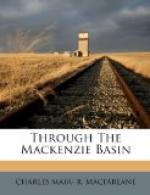It was necessary in order to prevent the issue of scrip to parties who had already received it elsewhere. But to the credit of the Lesser Slave Lake community, few efforts were made to “come in” again, not one in fact which was a clear attempt at fraud, or which could not be accounted for by false agency. Indeed, a high tribute might well be paid here to the honesty, not only of this but of all the communities, both Indian and half-breed, throughout these remote territories. We found valuable property exposed, everywhere, evidently without fear of theft. There was a looser feeling regarding debts to traders, which we were told were sometimes ignored, partly, perhaps, owing to the traders’ heavy profits, but mainly through failure in the hunt and a lack of means. But theft such as white men practice was a puzzle to these people, amongst whom it was unknown.
The most noticeable feature of the scrip issue was the never-ending stream of applicants, a surprising evidence of the growth of population in this remote wilderness. Its most interesting feature lay in the peculiarities and manners of the people themselves. They were unquestionably half-breeds, and had received Christian names, and most of them had houses of their own, and, though hunters, fishermen and trippers, their families lived comparatively settled lives. Yet the glorious instinct of the Indian haunted them. As a rule they had been born on the “pitching-track,” in the forest, or on the prairies—in all sorts of places, they could not say exactly where—and when they were born was often a matter of doubt as well. [With reference to these nondescript birthplaces, the wonderful ease of parturition among Indian women may be referred to here. This is common, probably, to all primitive races, but is perhaps more marked amongst Indian mothers than any other. The event may happen in a canoe, on the trail, at any place, or at any moment, without hindering the ordinary progress of a travelling party, which is generally overtaken by the mother in a few hours. But nothing I heard here equalled in grotesque circumstances occurrences, whose truth I can vouch for, many years ago on the Saskatchewan River. In 1874, if I remember aright, a great spring freshet in the North Branch was accompanied by a tremendous ice-jam, which backed the water up, and flooded the river bank so suddenly that many Indians were drowned. On an island below Prince Albert, a woman, to save her life, had to climb a neighbouring tree, and gave birth to a child amongst the branches. The jam broke, and, wonderful to say, both mother and child got down to firm ground alive. Another case, even more gruesome, happened on the Lower Saskatchewan not so many years ago. A woman and her husband were hastening on snowshoes from their winter camp to the river, in order to share in the usual Christmas bounty and festivities at the Hudson’s Bay Company’s post. The woman was seized with incipient labour, and darting from her husband, with whom she had been




